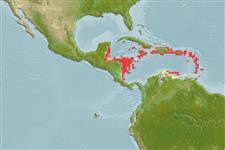>
Blenniiformes (Blennies) >
Chaenopsidae (Pike-, tube- and flagblennies)
Etymology: Acanthemblemaria: Greek, akantha = thorn + Greek, emblema, -atos, anything that is nailed, knocked in; also anything with bass or high relief (Ref. 45335).
Environment: milieu / climate zone / depth range / distribution range
Écologie
marin récifal. Subtropical; 20°N - 10°N, 90°W - 58°W (Ref. 56264)
Western Atlantic: southeastern Florida (USA), Bahamas, and Yucatan, Mexico to the Greater Antilles and Panama. Antilles and western Caribbean (Ref. 26938).
Taille / Poids / Âge
Maturity: Lm ? range ? - ? cm
Max length : 4.0 cm TL mâle / non sexé; (Ref. 7251)
Almost always found in holes of corals. Feed on amphipods and copepods (Ref. 5521). Main diet of benthic harpacticoid copepods (Ref. 94105). Oviparous (Ref. 56066). Eggs are attached to the walls of the parent's shelter and are brooded by the male parent (Ref. 56066).
Life cycle and mating behavior
Maturities | Reproduction | Spawnings | Egg(s) | Fecundities | Larves
Oviparous (Ref. 56066). Males guard the eggs until they hatch (Ref. 56065).
Robins, C.R. and G.C. Ray, 1986. A field guide to Atlantic coast fishes of North America. Houghton Mifflin Company, Boston, U.S.A. 354 p. (Ref. 7251)
Statut dans la liste rouge de l'IUCN (Ref. 130435)
Menace pour l'homme
Harmless
Utilisations par l'homme
Pêcheries: commercial; Aquarium: Commercial
Outils
Articles particuliers
Télécharger en XML
Sources Internet
Estimates based on models
Preferred temperature (Ref.
123201): 27.3 - 28.2, mean 27.9 °C (based on 226 cells).
Phylogenetic diversity index (Ref.
82804): PD
50 = 0.5000 [Uniqueness, from 0.5 = low to 2.0 = high].
Bayesian length-weight: a=0.00457 (0.00183 - 0.01143), b=3.08 (2.86 - 3.30), in cm total length, based on LWR estimates for this (Sub)family-body shape (Ref.
93245).
Niveau trophique (Ref.
69278): 3.1 ±0.32 se; based on food items.
Résilience (Ref.
120179): Milieu, temps minimum de doublement de population : 1,4 à 4,4 années (tmax=4).
Fishing Vulnerability (Ref.
59153): Low vulnerability (10 of 100).
Nutrients (Ref.
124155): Calcium = 141 [49, 308] mg/100g; Iron = 0.856 [0.424, 1.742] mg/100g; Protein = 18.7 [17.4, 19.9] %; Omega3 = 0.164 [0.075, 0.342] g/100g; Selenium = 7.84 [2.82, 21.43] μg/100g; VitaminA = 172 [42, 704] μg/100g; Zinc = 1.86 [1.03, 3.10] mg/100g (wet weight);
